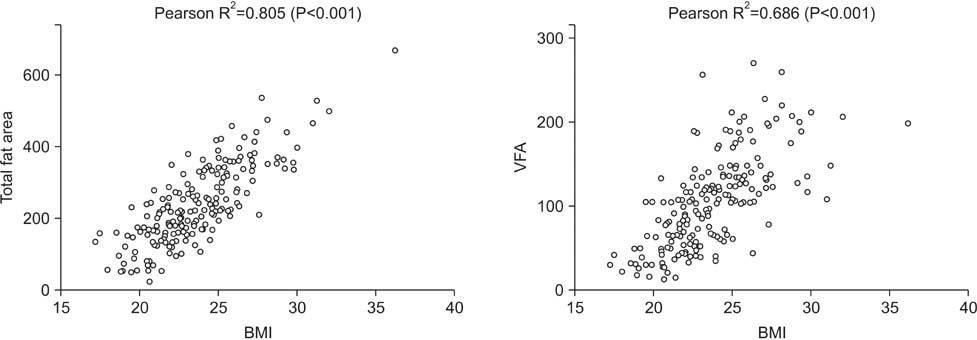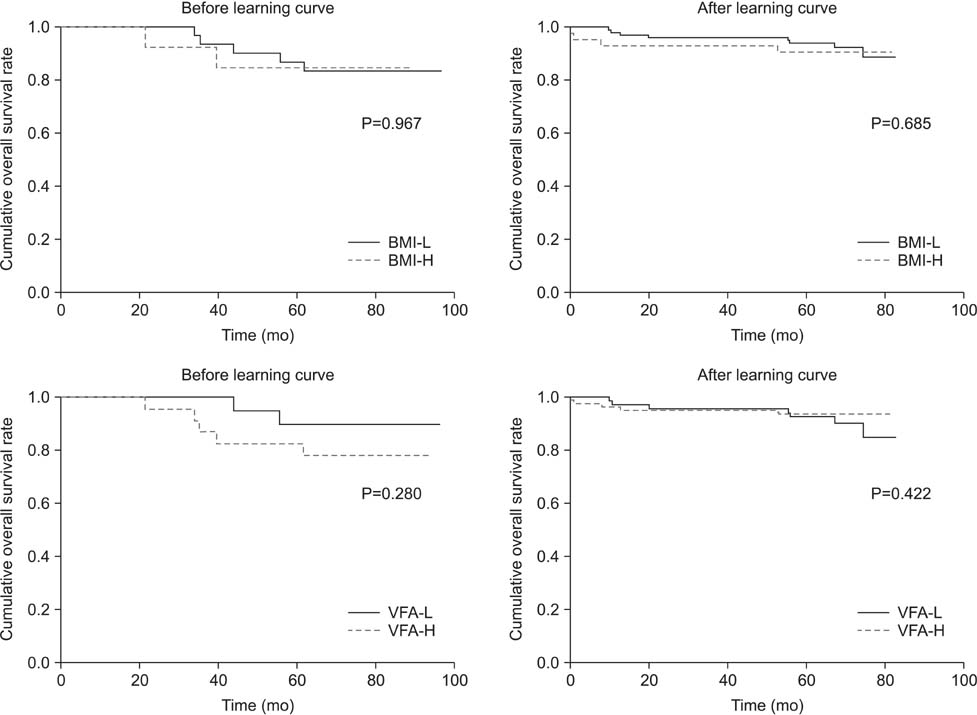J Gastric Cancer.
2015 Sep;15(3):151-158. 10.5230/jgc.2015.15.3.151.
Is There any Role of Visceral Fat Area for Predicting Difficulty of Laparoscopic Gastrectomy for Gastric Cancer?
- Affiliations
-
- 1Department of Surgery, Ajou University School of Medicine, Suwon, Korea. sonsy@aumc.ac.kr
- 2Department of Radiology, Ajou University School of Medicine, Suwon, Korea.
- KMID: 2372200
- DOI: http://doi.org/10.5230/jgc.2015.15.3.151
Abstract
- PURPOSE
Obesity is associated with morbidity following gastric cancer surgery, but whether obesity influences morbidity after laparoscopic gastrectomy (LG) remains controversial. The present study evaluated whether body mass index (BMI) and visceral fat area (VFA) predict postoperative complications.
MATERIALS AND METHODS
A total of 217 consecutive patients who had undergone LG for gastric cancer between May 2003 and December 2005 were included in the present study. We divided the patients into two groups ('before learning curve' and 'after learning curve') based on the learning curve effect of the surgeon. Each of these groups was sub-classified according to BMI (<25 kg/m2 and > or =25 kg/m2) and VFA (<100 cm2 and > or =100 cm2). Surgical outcomes, including operative time, quantity of blood loss, and postoperative complications, were compared between BMI and VFA subgroups.
RESULTS
The mean operative time, length of hospital stay, and complication rate were significantly higher in the before learning curve group than in the after learning curve group. In the subgroup analysis, complication rate and length of hospital stay did not differ according to BMI or VFA; however, for the before learning curve group, mean operative time and blood loss were significantly higher in the high VFA subgroup than in the low VFA subgroup (P=0.047 and P=0.028, respectively).
CONCLUSIONS
VFA may be a better predictive marker than BMI for selecting candidates for LG, which may help to get a better surgical outcome for inexperienced surgeons.
MeSH Terms
Figure
Reference
-
1. Hayashi H, Ochiai T, Shimada H, Gunji Y. Prospective randomized study of open versus laparoscopy-assisted distal gastrectomy with extraperigastric lymph node dissection for early gastric cancer. Surg Endosc. 2005; 19:1172–1176.2. Huscher CG, Mingoli A, Sgarzini G, Sansonetti A, Di Paola M, Recher A, et al. Laparoscopic versus open subtotal gastrectomy for distal gastric cancer: five-year results of a randomized prospective trial. Ann Surg. 2005; 241:232–237.3. Jiang L, Yang KH, Guan QL, Cao N, Chen Y, Zhao P, et al. Laparoscopy-assisted gastrectomy versus open gastrectomy for resectable gastric cancer: an update meta-analysis based on randomized controlled trials. Surg Endosc. 2013; 27:2466–2480.4. Kim YW, Yoon HM, Yun YH, Nam BH, Eom BW, Baik YH, et al. Long-term outcomes of laparoscopy-assisted distal gastrectomy for early gastric cancer: result of a randomized controlled trial (COACT 0301). Surg Endosc. 2013; 27:4267–4276.5. Adachi Y, Suematsu T, Shiraishi N, Katsuta T, Morimoto A, Kitano S, et al. Quality of life after laparoscopy-assisted Billroth I gastrectomy. Ann Surg. 1999; 229:49–54.6. Kim HH, Han SU, Kim MC, Hyung WJ, Kim W, Lee HJ, et al. Long-term results of laparoscopic gastrectomy for gastric cancer: a large-scale case-control and case-matched Korean multicenter study. J Clin Oncol. 2014; 32:627–633.7. Son SY, Jung DH, Lee CM, Ahn SH, Ahn HS, Park do J, et al. Laparoscopic gastrectomy versus open gastrectomy for gastric cancer in patients with body mass index of 30 kg/m(2) or more. Surg Endosc. 2015; 29:2126–2132.8. Son SY, Lee CM, Jung DH, Lee JH, Ahn SH, Park do J, et al. Laparoscopic completion total gastrectomy for remnant gastric cancer: a single-institution experience. Gastric Cancer. 2015; 18:177–182.9. Kim HH, Son SY, Ahn S, Han SU. Reply to M. Honda et al. J Clin Oncol. 2014; 32:3201–3202.10. Kunisaki C, Makino H, Takagawa R, Sato K, Kawamata M, Kanazawa A, et al. Predictive factors for surgical complications of laparoscopy-assisted distal gastrectomy for gastric cancer. Surg Endosc. 2009; 23:2085–2093.11. Hiki N, Fukunaga T, Yamaguchi T, Ogura T, Miyata S, Tokunaga M, et al. Increased fat content and body shape have little effect on the accuracy of lymph node retrieval and blood loss in laparoscopic distal gastrectomy for gastric cancer. J Gastrointest Surg. 2009; 13:626–633.12. Lee HJ, Kim HH, Kim MC, Ryu SY, Kim W, Song KY, et al. Korean Laparoscopic Gastrointestinal Surgery Study Group. The impact of a high body mass index on laparoscopy assisted gastrectomy for gastric cancer. Surg Endosc. 2009; 23:2473–2479.13. Ojima T, Iwahashi M, Nakamori M, Nakamura M, Takifuji K, Katsuda M, et al. The impact of abdominal shape index of patients on laparoscopy-assisted distal gastrectomy for early gastric cancer. Langenbecks Arch Surg. 2012; 397:437–445.14. Go JE, Kim MC, Kim KH, Oh JY, Kim YM. Effect of visceral fat area on outcomes of laparoscopyassisted distal gastrectomy for gastric cancer: subgroup analysis by gender and parameters of obesity. Ann Surg Treat Res. 2015; 88:318–324.15. Sugisawa N, Tokunaga M, Tanizawa Y, Bando E, Kawamura T, Terashima M. Intra-abdominal infectious complications following gastrectomy in patients with excessive visceral fat. Gastric Cancer. 2012; 15:206–212.16. Ueda J, Ichimiya H, Okido M, Kato M. The impact of visceral fat accumulation on laparoscopy-assisted distal gastrectomy for early gastric cancer. J Laparoendosc Adv Surg Tech A. 2009; 19:157–162.17. Miyaki A, Imamura K, Kobayashi R, Takami M, Matsumoto J. Impact of visceral fat on laparoscopy-assisted distal gastrectomy. Surgeon. 2013; 11:76–81.18. Jin SH, Kim DY, Kim H, Jeong IH, Kim MW, Cho YK, et al. Multidimensional learning curve in laparoscopy-assisted gastrectomy for early gastric cancer. Surg Endosc. 2007; 21:28–33.19. Kubo M, Sano T, Fukagawa T, Katai H, Sasako M. Increasing body mass index in Japanese patients with gastric cancer. Gastric Cancer. 2005; 8:39–41.20. Khang YH, Yun SC. Trends in general and abdominal obesity among Korean adults: findings from 1998, 2001, 2005, and 2007 Korea National Health and Nutrition Examination Surveys. J Korean Med Sci. 2010; 25:1582–1588.21. Oh SW, Shin SA, Yun YH, Yoo T, Huh BY. Cut-off point of BMI and obesity-related comorbidities and mortality in middle-aged Koreans. Obes Res. 2004; 12:2031–2040.22. Kim KH, Kim MC, Jung GJ, Kim HH. The impact of obesity on LADG for early gastric cancer. Gastric Cancer. 2006; 9:303–307.23. Shim JH, Song KY, Kim SN, Park CH. Laparoscopy-assisted distal gastrectomy for overweight patients in the Asian population. Surg Today. 2009; 39:481–486.24. Kim MC, Jung GJ, Kim HH. Learning curve of laparoscopy-assisted distal gastrectomy with systemic lymphadenectomy for early gastric cancer. World J Gastroenterol. 2005; 11:7508–7511.25. Yoo CH, Kim HO, Hwang SI, Son BH, Shin JH, Kim H. Short-term outcomes of laparoscopic-assisted distal gastrectomy for gastric cancer during a surgeon's learning curve period. Surg Endosc. 2009; 23:2250–2257.26. Kim JH, Chin HM, Hwang SS, Jun KH. Impact of intra-abdominal fat on surgical outcome and overall survival of patients with gastric cancer. Int J Surg. 2014; 12:346–352.
- Full Text Links
- Actions
-
Cited
- CITED
-
- Close
- Share
- Similar articles
-
- Laparoscopic Distal Gastrectomy for Gastric Cancer
- Laparoscopic Surgery for Advanced Gastric Cancer: Current Status and Future Perspectives
- Intracorporeal Anastomosis in Laparoscopic Gastric Cancer Surgery
- Entirely Laparoscopic Gastrectomy and Colectomy for Remnant Gastric Cancer with Gastric Outlet Obstruction and Transverse Colon Invasion
- Midterm body composition changes after open distal gastrectomy for early gastric cancer



